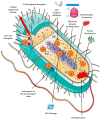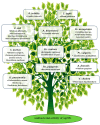Green Silver Nanoparticles: An Antibacterial Mechanism
- PMID: 39858291
- PMCID: PMC11762094
- DOI: 10.3390/antibiotics14010005
Green Silver Nanoparticles: An Antibacterial Mechanism
Erratum in
-
Correction: Mikhailova, E.O. Green Silver Nanoparticles: An Antibacterial Mechanism. Antibiotics 2025, 14, 5.Antibiotics (Basel). 2025 Oct 30;14(11):1092. doi: 10.3390/antibiotics14111092. Antibiotics (Basel). 2025. PMID: 41301670 Free PMC article.
Abstract
Silver nanoparticles (AgNPs) are a promising tool in the fight against pathogenic microorganisms. "Green" nanoparticles are especially valuable due to their environmental friendliness and lower energy consumption during production, as well as their ability to minimize the number of toxic by-products. This review focuses on the features of AgNP synthesis using living organisms (bacteria, fungi, plants) and the involvement of various biological compounds in this process. The mechanism of antibacterial activity is also discussed in detail with special attention given to anti-biofilm and anti-quorum sensing activities. The toxicity of silver nanoparticles is considered in light of their further biomedical applications.
Keywords: AgNPs; anti-biofilm activity; anti-“quorum sensing” activity; antibacterial activity; green synthesis; silver nanoparticles.
Conflict of interest statement
The author declares no conflicts of interest.
Figures





References
-
- Okaiyeto K., Omotuyi I.O., Oguntibeju O.O. Global mapping of research trends on antibacterial activity of green silver nanoparticles. Plant Sci. Today. 2022;9:105–118. doi: 10.14719/pst.1316. - DOI
-
- Kumar M., Upadhyay L.S.B., Kerketta A., Vasanth D. Extracellular Synthesis of Silver Nanoparticles Using a Novel Bacterial Strain Kocuria rhizophila BR-1: Process Optimization and Evaluation of Antibacterial Activity. BioNanoScience. 2022;12:423–438. doi: 10.1007/s12668-022-00968-0. - DOI
Publication types
LinkOut - more resources
Full Text Sources

